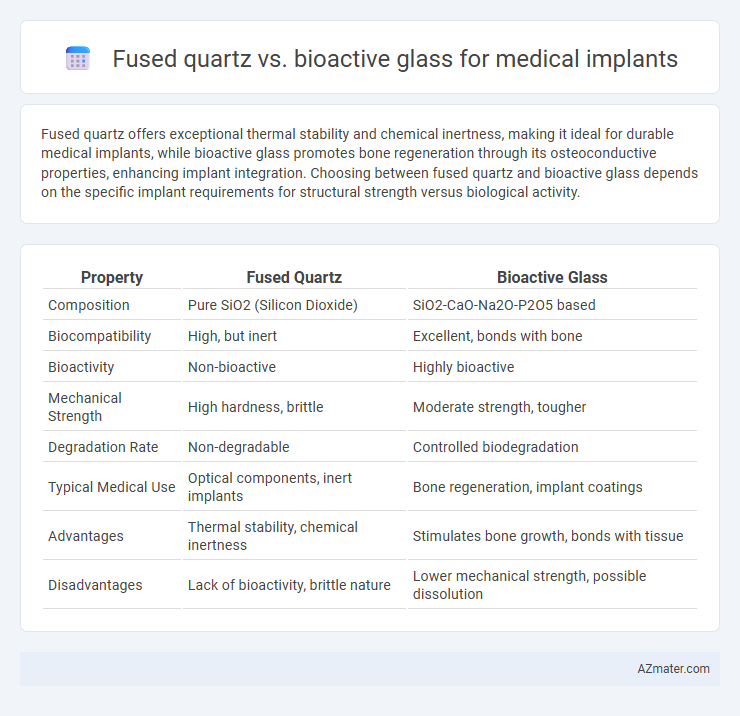Fused quartz offers exceptional thermal stability and chemical inertness, making it ideal for durable medical implants, while bioactive glass promotes bone regeneration through its osteoconductive properties, enhancing implant integration. Choosing between fused quartz and bioactive glass depends on the specific implant requirements for structural strength versus biological activity.
Table of Comparison
| Property | Fused Quartz | Bioactive Glass |
|---|---|---|
| Composition | Pure SiO2 (Silicon Dioxide) | SiO2-CaO-Na2O-P2O5 based |
| Biocompatibility | High, but inert | Excellent, bonds with bone |
| Bioactivity | Non-bioactive | Highly bioactive |
| Mechanical Strength | High hardness, brittle | Moderate strength, tougher |
| Degradation Rate | Non-degradable | Controlled biodegradation |
| Typical Medical Use | Optical components, inert implants | Bone regeneration, implant coatings |
| Advantages | Thermal stability, chemical inertness | Stimulates bone growth, bonds with tissue |
| Disadvantages | Lack of bioactivity, brittle nature | Lower mechanical strength, possible dissolution |
Introduction to Fused Quartz and Bioactive Glass in Medical Implants
Fused quartz is a high-purity glass notable for its exceptional biocompatibility, mechanical strength, and resistance to thermal and chemical degradation, making it ideal for durable medical implants. Bioactive glass, composed primarily of silica, calcium oxide, and phosphorus pentoxide, promotes bone regeneration by forming a hydroxycarbonate apatite layer that bonds directly with living tissue. Both materials offer distinct advantages in implant technology, with fused quartz providing structural stability and bioactive glass facilitating biological integration and healing.
Composition and Material Properties Comparison
Fused quartz, composed primarily of pure silicon dioxide (SiO2), offers exceptional thermal stability, chemical inertness, and high mechanical strength, making it suitable for durable medical implants needing resistance to corrosion and wear. Bioactive glass, typically comprised of silica (SiO2), calcium oxide (CaO), sodium oxide (Na2O), and phosphorus pentoxide (P2O5), promotes bone bonding and tissue regeneration due to its surface bioactivity and controlled biodegradability. The key difference lies in fused quartz's non-reactive nature versus bioactive glass's ability to chemically interact with biological tissues, enhancing osteointegration in implant applications.
Biocompatibility: Fused Quartz vs Bioactive Glass
Bioactive glass exhibits superior biocompatibility compared to fused quartz due to its ability to bond directly with bone and promote tissue regeneration through controlled ion release. Fused quartz, while chemically inert and stable, lacks bioactivity and does not support cellular adhesion or integration with biological tissues. The bioactivity of bioactive glass enhances osteointegration and reduces implant rejection rates, making it a preferred choice for medical implants requiring active tissue interaction.
Mechanical Strength and Durability
Fused quartz exhibits exceptional mechanical strength and high resistance to thermal shock, making it suitable for implants requiring long-term structural stability. Bioactive glass, while possessing lower mechanical strength compared to fused quartz, offers superior biological integration through its ability to bond with bone tissue and promote regeneration. Durability-wise, fused quartz provides excellent corrosion resistance and longevity, whereas bioactive glass prioritizes bioactivity and gradual resorption aligned with tissue healing processes.
Bioactivity and Osseointegration Potential
Bioactive glass exhibits superior bioactivity compared to fused quartz, actively forming a hydroxycarbonate apatite layer that bonds directly with bone tissue, enhancing osseointegration potential. Unlike the inert nature of fused quartz, bioactive glass stimulates cellular responses and supports new bone growth, making it highly suitable for medical implants requiring strong bone-implant integration. This reactive interface improves implant stability and accelerates healing, critical factors in orthopedic and dental implant applications.
Clinical Applications and Use Cases
Fused quartz offers excellent biocompatibility and chemical stability, making it ideal for optical components and sensors in medical implants, particularly in neural interfaces and diagnostic devices. Bioactive glass promotes bone regeneration and osseointegration, widely used in orthopedic and dental implants to enhance healing and integrate with native bone tissue. Clinical applications of bioactive glass include bone graft substitutes and coating materials for implants, whereas fused quartz is preferred for implantable devices requiring long-term chemical inertness and optical clarity.
Manufacturing Processes and Cost Efficiency
Fused quartz is manufactured through melting high purity silica at extremely high temperatures, resulting in a dense, inert material well-suited for precision medical implants but often requiring energy-intensive processes that raise production costs. Bioactive glass is produced via sol-gel or melt-quenching methods, offering a bioactive surface that promotes osseointegration while typically enabling lower temperature processing and more cost-effective scalability. The cost efficiency of bioactive glass stems from its easier manufacturing, superior biological integration reducing long-term medical expenses, and versatility in shaping complex implant forms compared to the more rigid and costly fused quartz fabrication.
Longevity and Implant Lifespan
Fused quartz offers exceptional chemical durability and thermal stability, contributing to a long implant lifespan by resisting degradation in the body. Bioactive glass promotes bone bonding and stimulates tissue regeneration, potentially enhancing implant longevity through biological integration but may exhibit gradual resorption over time. Selecting between fused quartz and bioactive glass depends on balancing the need for mechanical stability with the desired bioactivity for long-term implant success.
Recent Research and Innovations
Recent research highlights the enhanced biocompatibility and bioactivity of bioactive glass compared to fused quartz, particularly in bone regeneration and tissue integration applications. Innovations in bioactive glass include the development of composite materials with tailored degradation rates and the incorporation of therapeutic ions that promote accelerated healing and antibacterial properties. Fused quartz remains valued for its mechanical strength and chemical inertness but shows limited bioactivity, positioning bioactive glass as a superior choice for advanced medical implants requiring active biological responses.
Future Prospects in Medical Implant Technology
Fused quartz offers exceptional chemical stability and low thermal expansion, making it ideal for applications requiring long-term durability in medical implants. Bioactive glass promotes bone regeneration and integration by releasing ions that stimulate cellular activity, positioning it as a promising material for next-generation implants focused on biological compatibility. Future prospects in medical implant technology emphasize combining fused quartz's mechanical stability with bioactive glass's regenerative properties to develop hybrid implants with enhanced performance and longevity.

Infographic: Fused quartz vs Bioactive glass for Medical implant
 azmater.com
azmater.com